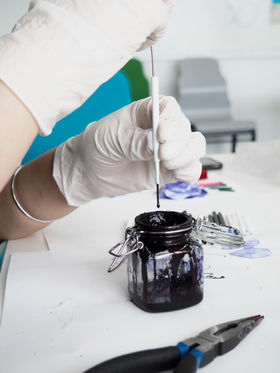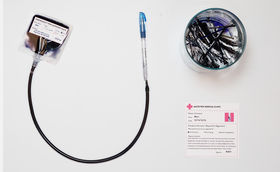Beyond a Pen

Beyond a Pen
The project of our group is about increasing the emotional value between a user and an object. We wanted to question current technology and manufacturing systems that are usually based on mass-production. We should question especially our consuming habits and we shouldn’t take objects for granted. There are so many products in our everyday life that we don’t value. Modern technology and consumerism has led to numerous disposable products that are used only one time and then been thrown away. The most undervalued items are the smallest and cheapest ones. We ended up using a pen as a medium because it has a bigger impact on our lives than we realise.
Group members:
Bingdie Huang, Sirena Nieminen, Merituuli Porras , Irene Purasachit, Emma Sivusalo, Korinna Szabó
Research
Research Technology has changed our ways of communicating. The technology behind pen manufacturing has improved a lot due to humanity's communication needs. The form of a pen hasn't changed much during the last 150 years but that doesn’t mean we stopped developing.(1)(2) And although we are now also using a smart pen we still have the feeling that it’s an evolved version of an earlier state of matter. What kind of pens will we have in the future? Technology has enabled us to live in modern society but it also has some downsides such as overconsumption, difficulties in waste management and huge pollution problems. Consumerism, cheap manufacturing and low labor costs altogether have led us to a situation where we’re facing serious environmental problems. Technology = Efficiency > Mass production > Overconsumption > Waste management problems Modern ballpoint pens are said to have a two-year lifetime on average(3) but why do we see pens as disposable items? Is it because pens are usually so cheap that they’re easily replaceable by buying new instead of refilling the old one? Why do we act like this? What can we as designers do What kind of relations we have with the items we use everyday?

Our research was based on an evolution of pen as a tool of communicating (4), the complication of pen’s manufacturing (5)(6)(7), the pen’s lifecycle (8) and the emotional value between human and daily objects. (9) The aim of this project was not to educate people of how pens were made but rather questioning our habits and value by experimenting on creating an emotional connection between users and products.
SOURCES:
1. Wall Street Journal. 2017. What Took China So Long to Master Ballpoint Pens. https:// www.youtube.com/watch?v=RrPlOM5MTSM (Viewed 00.09.2019)
2. Atkinson, Simon. 2017. Pen Power: China Closer to Ballpoint Success. https://www.bbc.com/ news/business-38566114 (Viewed 00.09.2019)
3. Russel-Ausley, Melissa. 2017. How Ballpoint Pens Work. https://home.howstuffworks.com/ pen.htm (Viewed 00.09.2019)
4. Bellis, Mary. 2018. A Brief History of Writing. https://www.thoughtco.com/brief-history-ofwriting-4072560 (Viewed 00.09.2019)
5. BIC Group Official. 2016. BIC® Cristal® ball pen manufacturing.https://www.youtube.com/ watch?v=-OxsoPxc8SY (Viewed 00.09.2019)
6. Grace John. 2011. How to Make Ball Pen.https://www.youtube.com/watch?v=4i7Z8ma1R6w (Viewed 00.09.2019)
7. Lemon, Michael. 2015. Bic Cristal Pens - Raw Materials+Manufacturing. https://u.osu.edu/ bicpens/02-raw-materials/ (Viewed 00.09.2019)
8. Bouthsarath, Nona. 2016. Life Cycle of a Bic Cristal Ballpoint Pen. http://www.designlifecycle.com/bic-cristal-ballpoint-pen (Viewed 00.09.2019) 9. Donald A. Norman. 2004. Emotional Design - Why We Love (or Hate) Everyday Things

The process
We aimed to increase empathy towards pens to see the possibilities of creating more value towards our daily used objects and what are the consequences of doing so.
What is the most effective way to grow empathy? What if the objects had personalities and emotions just like us humans? Is it possible to create an emotional connection by humanizing something that is not alive?
We decided to humanize pens by giving them their own characteristics and voices. For engaging people in the early stages we asked people to collaborate by donating their unwanted pens We received almost 400 pens, range from pencils to refillable pens plus markers and ballpoint pens by putting boxes around Aalto Otaniemi campus (Väre building, Harald Herlin Learning Centre and Undergraduate Centre) and collected pens in metro, in central Helsinki and from our friends and classmates in just one week. We also asked the donor to write a goodbye message for their donated pens. After analyzing the messages we noticed that only a small number of people had any kind of connection to the pen they donated.
We noticed that in many cases price and functionality were not significant factors because people also threw away pens that were still working or had a lot of value moneywise.Some pens were broken in different ways being the main reason for giving them up. We got an idea of a pen adoption where we could bring together a donated pen to a new owner when we started to think of how to display both the broken and the intact ones. We also wanted to highlight the complexity of recycling the pens. Pens consist of various materials such as plastic, metal and ink and they are usually thrown in to mixed waste.

The outcome
The project outcome aimed to question human behaviour from the “technology lens” point of view in terms of overconsumption, recycling and lack of emotion towards the objects we use on a daily basis. The exhibition “Beyond a pen” showcased the collected pens in three parts. The intact ones were put into “adoption” – we created individual stories and characteristics to 12 pens and used illustrations to support the written part. To be more effective and humanising we recorded voice overs to play in the exhibition.
We chose some of the broken pens to exhibit as patients of “a pen hospital”. To create emotion and highlight the need of a treatment we made hospital props in the vicinity of the pens. The hospital was divided into “organ transplantation”, “ink transfusion” and “plastic casting” so that each of them represented the controversy and challenges of both waste management and ignorance.
We had a lot of excessive pens both intact and broken. The parts of the broken ones were separated into plastic, metal and ink and then presented in containers to show the amount of waste, the capability of recycling and the proportions of each material compared to others.
Pens and Their Stories
We chose some of the broken pens to exhibit as patients of “a pen hospital”. To create emotion and highlight the need of a treatment we made hospital props in the vicinity of the pens. The hospital was divided into “organ transplantation”, “ink transfusion” and “plastic casting” so that each of them represented the controversy and challenges of both waste management and ignorance. We had a lot of excessive pens both intact and broken. The parts of the broken ones were separated into plastic, metal and ink and then presented in containers to show the amount of waste, the capability of recycling and the proportions of each material compared to others.
















